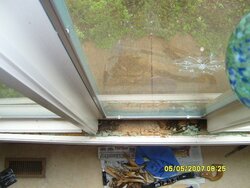velvetfoot
Minister of Fire
They say urethane caulk is good for concrete. I should do the cracks in the basement for radon reasons, but haven't done it yet. I already bought some for that and to stop some water coming in around the well pipe penetration.
Where I had read about the discoloration with plumbers putty and plastic and marble, was when I put in a marble tile floor a couple of months ago. Then the ceiling below started sagging around 4:00 AM when we were trying to catch a plane. It was actually the paint sagging, luckily. I thought it was the toilet seal-I tried a new-fangled no-wax seal. But nooooooooo. I had put water in the tub before caulking the bottom-floor joint: I read that somewhere. Turns out there was a leak in the drain. The shower valve is operated with a tilting lever that moves a cylinder within a pipe that blocks flow of water from the tub. When there is water in the tub there is pressure in this pipe from the head of water in the tub. Alas, there is also a slip-ring type compression joint (like you have under your typical sink) that is required to hold this pressure. I've always thought those joints were kind of lame. It just needed tightening. Of course to get at it I had to remove the vanity that was on the wall in back of the shower/tub. I planned to use that borescope I mentioned in another thread to look at it from below, but alas, I had messed up the cultured marble vanity top (subsequently replaced with granite) with a stain (and subsequent failed stain removal) so the thing had to come out anyway. It was evident the joint had been leaking from the mineral stains. I hardly ever take a bath so that's why it wasn't noticed earlier.
In re-reading this post, I seem to use the word "alas" a lot, alas.
Where I had read about the discoloration with plumbers putty and plastic and marble, was when I put in a marble tile floor a couple of months ago. Then the ceiling below started sagging around 4:00 AM when we were trying to catch a plane. It was actually the paint sagging, luckily. I thought it was the toilet seal-I tried a new-fangled no-wax seal. But nooooooooo. I had put water in the tub before caulking the bottom-floor joint: I read that somewhere. Turns out there was a leak in the drain. The shower valve is operated with a tilting lever that moves a cylinder within a pipe that blocks flow of water from the tub. When there is water in the tub there is pressure in this pipe from the head of water in the tub. Alas, there is also a slip-ring type compression joint (like you have under your typical sink) that is required to hold this pressure. I've always thought those joints were kind of lame. It just needed tightening. Of course to get at it I had to remove the vanity that was on the wall in back of the shower/tub. I planned to use that borescope I mentioned in another thread to look at it from below, but alas, I had messed up the cultured marble vanity top (subsequently replaced with granite) with a stain (and subsequent failed stain removal) so the thing had to come out anyway. It was evident the joint had been leaking from the mineral stains. I hardly ever take a bath so that's why it wasn't noticed earlier.
In re-reading this post, I seem to use the word "alas" a lot, alas.




